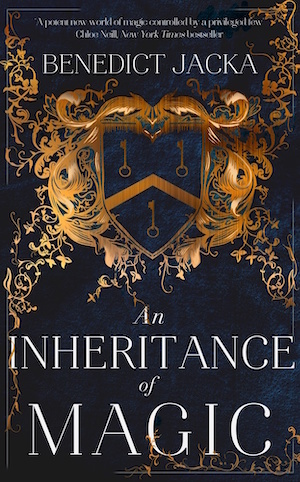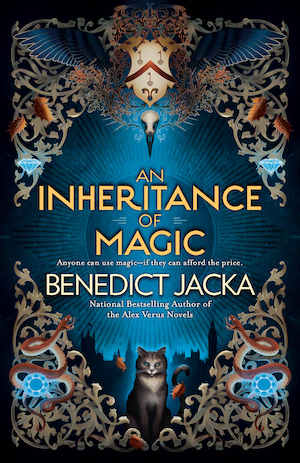Benedict Jacka's Blog, page 13
October 16, 2023
Reddit AMA tomorrow!
My Reddit AMA on r/fantasy will start tomorrow, at noon GMT! (That’s about 24 hours from now.) Come by if you have any questions about Inheritance of Magic, Alex Verus, or my writing in general.
I’ll put up a direct link to the thread when it goes live tomorrow. Once it’s up, I’ll answer questions for about 24 hours before bringing things to a close.
October 13, 2023
AMA Next Week & More Reviews
 My Reddit AMA is in four days! This’ll be the first one I’ve done in two years, so I’m looking forward to getting back into the swing of things.
My Reddit AMA is in four days! This’ll be the first one I’ve done in two years, so I’m looking forward to getting back into the swing of things.
For those who haven’t been around for one of these before (given that the last one was in 2021) AMA stands for “Ask Me Anything” and is a question-and-answer session where readers get to ask me anything they like about my books. Here’s the last one I did, after the release of Risen. I generally spread my AMAs out over 24 hours, so that everyone gets a chance to ask questions no matter their time zone, and I try to answer every question that gets asked.
We’ve also got a lot more Inheritance of Magic reviews coming in! Here are some of my favourites from:
The Irresponsible Reader
Runalong the Shelves
Books Of My Heart
Brainfluff
That’s all for now! Just a reminder that the AMA will begin on noon GMT on Tuesday 17th October, and will end on Wednesday 18th October at the same time. After that, next Friday’s blog post will be a round-up and roadmap as to what’s coming next.
October 10, 2023
Inheritance of Magic is out in the US & Canada!
And five days later than the UK, An Inheritance of Magic is out in North America as of today!
You can buy it here in paper, ebook, and audio format. Or if you just want to see what it’s like first, you can read the first chapters here.
Next week, on Tuesday 17th, I’ll be doing my traditional post-release question and answer session on r/fantasy. Drop by to ask me about Inheritance of Magic, Alex Verus, or just about anything else. Hopefully the one-week gap will have given a decent number of people enough time to have read the book!
October 6, 2023
Inheritance of Magic – Early Reviews
 For those who missed it, An Inheritance of Magic released yesterday in the UK and worldwide! Here are a couple of the more high-profile reviews, lightly edited to avoid major spoilers.
For those who missed it, An Inheritance of Magic released yesterday in the UK and worldwide! Here are a couple of the more high-profile reviews, lightly edited to avoid major spoilers.
A world of magic usually known only to the rich and powerful is put to the test in the page-turning urban fantasy that launches an intriguing new series from Jacka (the Alex Verus series). Twenty-year-old Stephen Oakwood ekes out a life in modern-day London by working low-wage jobs and renting a room in his aunt’s house. The only thing that really matters to him is fulfilling the promise he made to his father just before the man disappeared two years ago: namely, to keep practicing his drucraft, or magic. Stephen’s growing skill draws the wrong kind of attention, however . . . when people start trying to murder him, Stephen realizes he’s got much more to learn about the elite world of drucraft, its internal power struggles, and what his family has to do with all of it. Jacka provides immense detail about the ins and outs of drucraft, which will please fans of hard magic systems but occasionally slows down the story. Still, there’s lots of promise to this eat-the-rich world. Readers will be eager to see where things go next.
Young men living alone with their cats seem to be trending literarily. Benedict Jacka, the prolific author of the Alex Verus series, joins in with an appealing vision of contemporary fantasy in “An Inheritance of Magic.”
Stephen Oakwood is a young Londoner in a dead-end job; his mother left when he was a baby, and his father has mysteriously vanished. He has little going for him besides a few close friends, his pet cat, Hobbes, and a secret: Behind his closed bedroom door, Stephen practices magic, or “drucraft.” It is vaguely known in the wider world but dismissed by many as a weird hobby, while others hoard its secrets: In fact, the most powerful families, corporations and governments control it.
Stephen comes to understand the full truth about the commodification of drucraft when his distant cousin Lucella visits him as part of her plan to become heir of the Ashford family, a wealthy clan who wield both magic and wealth. The internecine battle she drags Stephen into imperils the life of the one thing in the world he has to care for: his beloved cat . . . Stephen’s tale makes for one of the most satisfying contemporary fantasies I have read in a long time; cozy and human, with some good fight scenes to boot. The succinctly explained treatment of magic even makes sense.
“An Inheritance of Magic” is an enchanting journey into a world where sorcery may be for sale, but agency is beyond price.
And as usual, there are plenty of reviews on the book’s Goodreads page.
For those of you in the US and Canada, the book gets its North American release on October 10th.
October 5, 2023
Inheritance of Magic releases today!
 And it’s finally here! An Inheritance of Magic, the first book in my new urban fantasy series, launches in the UK and worldwide today!
And it’s finally here! An Inheritance of Magic, the first book in my new urban fantasy series, launches in the UK and worldwide today!
This one has been a long, long time in the making. I wrote the first notes for Book 1 back in 2020, wrote the first draft in 2021, rewrote it and then rewrote it again in 2022, and ever since then I’ve been waiting for it to finish making its way through the publication process and hit the shelves (well, that and working on Book 2). But now, at last, the waiting’s over. My new series is out as of today!
I have to admit that I’m pretty nervous about this one. I’ve done everything I can to to make the book as good as possible – I spent a lot of time working on the setting and story, and an even longer time editing and polishing the book to make it as well-crafted as I could. But the fact is, it’s somewhere between very hard and impossible to guess in advance exactly how successful a book will be. Publishers and editors literally spend their entire careers trying to figure out which manuscript will be the next big thing, and even they constantly get it wrong. However, publishers can deal with this by spreading their bets – it’s no problem for them to have half a dozen books flop as long as the 7th one’s a hit. In my case, I kind of have to put all my eggs in one basket, so failures carry a much higher cost.
That said, early signs for Inheritance of Magic have been encouraging – I’ve had some nice early reviews from places like the Wall Street Journal and SFX magazine, and its current Goodreads score looks good. Ultimately, though, I won’t have a good picture of how it’s doing until a couple of months have gone by and the first big wave of readers have had the chance to read it and make up their minds. Till then – fingers crossed!
Anyway, that’s enough from me for now. You can read the first chapters here, and you can buy the book here, at least if you live outside of the US and Canada – for my North American readers, you’ll have to wait another 5 days until the US/Canadian release on October 10th. After that, the next big event on the schedule is my AMA on the 17th!
Hope you enjoy the story!
September 29, 2023
Release Week
Well, it’s been a long wait, but we’re finally into release week! An Inheritance of Magic is released in the UK and worldwide next Thursday, on the 5th of October.
Sorry for the relatively sparse content the past few weeks – I haven’t had much mental space for the fun side stuff that I try to put up here on this blog, like worldbuilding articles. The limited content is likely to continue for another couple of months, but I should gradually ease back into things by November or December. If it’s any consolation, it’s not going to affect my book release schedule – Book 2 is with my editors, and I should be able to start Book 3 around the end of the year, as planned . . .
. . . at least, assuming the Inheritance series doesn’t flop. I’ve been reading early reviews and reactions, though, and at this point I’m fairly sure it won’t. It’s always hard to predict how a new series will do, but by now I’m reasonably confident that the Inheritance of Magic series will be successful. I don’t know exactly how successful – it’ll be months at least before I have any clear picture of that, and years is more likely. If I had to guess, I’d say it’ll probably end up somewhere comparable to Alex Verus, but that’s very much a wild guess. We’ll have to see!
Anyway, UK release is October 5th, US release is October 10th, then after that the next big event will be my Reddit AMA, on October 17th. I’ll post more details about that closer to the time – hope to see you there!
September 22, 2023
Page Chewing Interview
Another interview for this week, this one with Steve at Page Chewing. I enjoyed this one, he’s a very easy-going host.
We’re inching closer and closer to the release of An Inheritance of Magic – UK release is less than two weeks away, on October 5th.
September 15, 2023
Fantology Interview is Live
Post is a little late this week since I was waiting for the Fantology interview to go up. It’s now live, and you can listen to it here! We talk about Alex Verus and An Inheritance of Magic.
September 8, 2023
Fantology Alex Verus Video Reviews
For a few months now, Fantology, a podcast focused on fantasy books, has been doing video reviews of the Alex Verus series. I just did an interview with them where they asked me questions about Alex Verus and Inheritance of Magic – it should go live in a week or two. In the meantime, here are the links of their Alex Verus reviews for those interested!
Alex Verus #1 – Fated
Alex Verus #2 and #3 – Cursed and Taken
Alex Verus #4 and #5 – Chosen and Hidden
Alex Verus #6 and #7 – Veiled and Burned
Alex Verus #8 and #9 – Bound and Marked
Alex Verus #10 and #11 – Fallen and Forged
Alex Verus #12 – Risen
Each is about an hour.
I’ve got a couple more interviews lined up now that we’re only a month away from An Inheritance of Magic’s release – I’ll let you know once they’re live!
September 1, 2023
Low Content For A While
Book #2 in the Inheritance of Magic series is with my publishers. I sent it off last weekend; now I just have to wait to hear back.
Unfortunately this is also going to mark the start of a slower period of blog content. My original plan for September had been to put up a few more Beginner’s Guide to Drucraft pieces covering topics like the drucraft Houses and corporations. However, some things have happened in my personal life and I’m going to have to take some time off. It won’t delay Book #1 or Book #2’s release, but posting is going to be light for a few weeks.
I should get back to more detailed blog posts closer to the release of An Inheritance of Magic on 5th/10th October.




